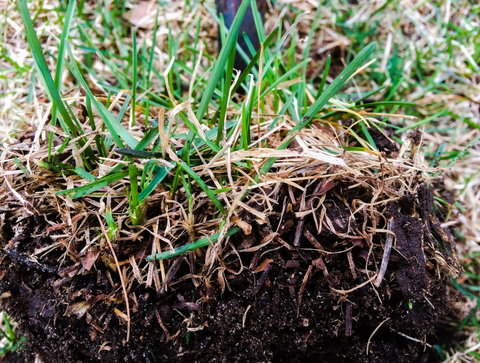Simple, Natural Lawn Care Tasks for Spring

Spring means it’s time to get outside and focus on that lawn of yours!
The exact timing of these spring lawn care tasks depends on the climate of your region. If you get snow in your area, then start when you are relatively confident the snow season is over and the ground has thawed
Here are some simple, chemical-free spring lawn care tasks you should do or think about to get your lawn out of winter mode, and set yourself up for lush, green lawn success all season long.
Take Stock of your Soil Health

Source: neavegroup.com
Soil health is a big part of plant health. When the soil is rich in micronutrients and micro-organisms, it is more resilient to pests, diseases, and heat throughout the summer.
Here are a couple simple ways you can improve your lawn's soil health.
· Aerate the Soil
Soil aeration is essential in yard maintenance and chemical-free lawn treatment. Aeration involves perforating the soil with small holes to allow air, water and nutrients to better penetrate the grass roots. If your soil composition is high in clay or very compacted (from use for example), it would be beneficial to aerate annually.
If you do not have an aerating tool, liquid aeration is a great approach to improving the soil's quality.
Early spring is a great time to aerate cool season grass whereas those with warm season grass may want to aerate in the late spring.
· Consider Thatch Control
Have you ever seen a solid build-up at the cross-section of soil and grass roots? This accumulation of organic matter is called thatch. While some organic matter, such as mulched leaves, break down quickly in a healthy lawn, other materials take longer to decompose. When buildup outpaces decomposition, your lawn’s thatch layer grows thicker.
A thin thatch’s layer of less than ½-inch thick is beneficial to the lawn as it acts as an organic mulch to conserve soil moisture and protect against big fluctuations in soil temperatures. But thatch layers of 1 inch or more become barriers instead of benefits, and can be a breeding ground for lawn disease and insect pests.
Always check your lawn’s thatch layer before dethatching. Take a garden trowel or spade and dig up a 4” deep wedge of your lawn’s grass and soil. If the thatch is 1-2 inches or more – it’s time for some thatch control.
The period of active growth and warming temperatures of spring are ideal for dethatching since it can be a somewhat invasive and aggressive practice, but exactly when in spring depends on the type of turf you have. Both warm-season and cold-season turf types should be dethatched after they are actively growing. As a rule of thumb, you should wait until after you’ve mowed it a couple of times.
You can hire a company to dethatch, or you can simply use a rake. Push the rake tines deeply down through the grass so they reach the layer that lies beneath.
Overseeding is your friend!

Overseeding is the process of adding more seeds to an existing lawn, helping encourage the growth of thick, healthy turf. It’s an easy way to fill in bare spots, improve the density of turf, and enhance your lawn’s color. Thick turf also outcompetes weeds, making overseeding a great natural weed control technique.
Spring is actually the second best time to overseed. Late summer/early fall is best because soil temps are even warmer than spring (faster germination), but the stressful, dry days of summer are over.
Pro Tip: Give it a quick rake and mow before overseeding, giving the seeds more access to the soil.
Feed the Grass
Apply a well-balanced fertilizer around the time of the first mowing. This will give nourishment to plant roots for strong growth.
Why do we always suggest natural? Organic and natural in this case means the product is only minimally processed, and the nutrients remain bound up in their natural forms, rather than being extracted and refined. They gradually release nutrients at a slower rate than chemical fertilizers, and as they break down, they improve the structure of the soil and increase its ability to hold water and nutrients. Over time, organic fertilizers will make your soil and plants healthy and strong.
Chemical or synthetic fertilizers, although show results a lot faster, do nothing for the soil and can damage plants by burning them is misapplied (ie. overapplied). synthetic ferts are high in salts which can be detrimental to soil microbes and they are subject to volatilization and leaching (look up those exciting terms).
Timely mowing and sharp mower blades
The first thing you need to do for a healthy, lush, and disease-free lawn is to get mowing. Spring is the ideal season to mow grass as it is actively growing.
Here are some spring mowing guidelines that can help encourage a green landscape:
- Make sure your blades are sharp. Dull blades can tear the grass, making it more susceptible to diseases and brown edges.
- Mow high. The taller the grass, the greater the rooting depth (thereby seeking out and accessing more moisture). Mow at a height of 3 to 3 ¼ inches.
- Do not mow when the grass is wet, and avoid working when it is scorching hot as it can add unnecessary stress to the lawn.
Important Tip: As a general rule, never mow more than one-third of the grass at any time. Yes, in the spring when things are growing like crazy, this could mean you need to mow more than once a week.
Happy lawn-ing this spring! If you have any questions or need help preparing your lawn for spring this year, don’t hesitate to reach out to care@otolawn.com.




Leave a comment